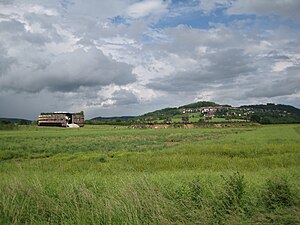Alise-Sainte-Reine
| Alise-Sainte-Reine | ||
|---|---|---|
|
|
||
| region | Bourgogne-Franche-Comté | |
| Department | Côte-d'Or | |
| Arrondissement | Montbard | |
| Canton | Montbard | |
| Community association | Pays d'Alésia et de la Seine | |
| Coordinates | 47 ° 32 ' N , 4 ° 29' E | |
| height | 237-404 m | |
| surface | 3.83 km 2 | |
| Residents | 579 (January 1, 2017) | |
| Population density | 151 inhabitants / km 2 | |
| Post Code | 21150 | |
| INSEE code | 21008 | |
 On the right side of the hill the village of Alise-Sainte-Reine, on the left the MuséoParc Alésia |
||
Alise-Sainte-Reine is a French commune with 579 inhabitants (as of January 1, 2017) on the Canal de Bourgogne in the Côte-d'Or department , Bourgogne-Franche-Comté region . According to archaeological, geographic and linguistic research results, ancient Alesia was probably located here.
history
After Julius Caesar conquered the Gallic fortress of Alesia defended by Vercingetorix in the Battle of Alesia , this oppidum , unlike many others, remained settled. It was only abandoned in the early Middle Ages . In the course of time new settlements emerged in the area. The largest of these is today's Alise-Sainte-Reine in the southwest of Mont Auxois.
The name Alise is probably derived from the old name Alesia, a local Burgundian deity named Alisanus is also known here . Sainte Reine (= Saint Regina ) goes back to a young woman named Reine , who was born here and who was martyred at the end of the 3rd century at the age of 15. Today she is buried here and is the patron saint of the community. According to a tradition that goes back to the year 866, a consecration play is performed for them every year on the last weekend in August.
At the end of July, the Nuits Péplum d'Alésia modern music festival is held in Alise-Sainte-Reine .
The canon and politician Félix Kir was born in the village in 1876; he was a member of the Resistance and from 1953 to 1967 age president of the French National Assembly . The mixed wine drink Kir is named after his favorite aperitif (white wine with a dash of crème de cassis ) .
Population development
| year | 1962 | 1968 | 1975 | 1982 | 1990 | 1999 | 2007 | 2016 |
| Residents | 699 | 755 | 707 | 717 | 667 | 674 | 660 | 586 |
| Sources: Cassini and INSEE | ||||||||
Attractions
- Remains of the columns, the octagonal inner sanctuary with adjoining rooms and a crypt, as well as several as yet unidentified square wall remains of a temple, today called Croix-Saint-Charles , are still preserved. Here some votive offerings and three dedicatory inscriptions have been found for the healing deity Moritasgus , in which he is named together with Apollo. The third inscription also names the goddess Damona as his consort.
- The 13th century church of St-Léger was partly built with stones from the walls of Alesia.
- One of Emperor Napoleon III. The colossal statue of Vercingetorix on Mont Auxois, commissioned in 1865, bears his facial features.
- The MuséoParc Alésia commemorates the Roman conquests with the Center d'interprétation de la bataille d'Alésia , a circular building with a diameter of 52 m and an area of 1,200 m².
- The archaeological park Site archéologique d'Alésia was to be merged with the MuséoParc in 2016 to form a total area of 7,000 ha. Statues of the deities Bergusia and Ucuetis were found here in a sanctuary .
Web links
- Alise-Sainte-Reine on the homepage of the Institut géographique national (accessed on July 1, 2012)
- Historical postcards by Alise-Sainte-Reine (accessed July 1, 2012)
- MuséoParc Alésia (accessed July 1, 2012)
Individual evidence
- ^ Bernhard Maier : Lexicon of Celtic Religion and Culture (= Kröner's pocket edition . Volume 466). Kröner, Stuttgart 1994, ISBN 3-520-46601-5 , p. 14 f.





